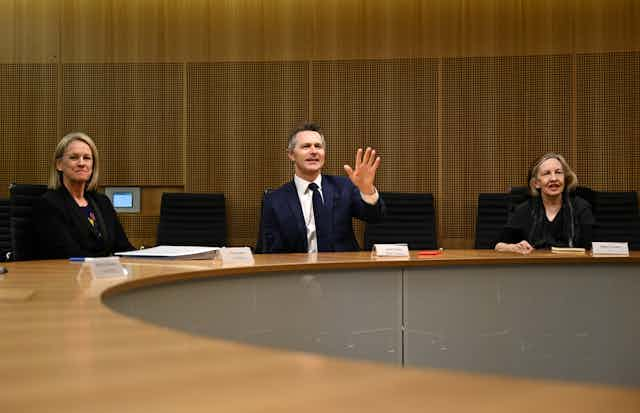Federal education Minister Jason Clare has released the highly-anticipated Universities Accord final report, billing it as a “blueprint” to change higher education for decades to come.
It is the first broad review of the sector since 2008. As The University of Melbourne’s Gwilym Croucher has noted it “could mean the most significant changes to higher education in a generation”.
More than a year in the making, the final report is 400 pages and contains 47 recommendations.
Where did it come from?
The Universities Accord started as a pre-election promise when Labor was in opposition. In 2021, then Labor education spokesperson Tanya Plibersek proposed to
seek to end some of the political bickering over higher education policy by establishing an Australian universities accord.
As higher education expert Gavin Moodie has written, the name invokes the landmark Prices and Incomes Accord, negotiated by the Hawke government and union movement.
But when the accord process was set up by Clare in November 2022, the emphasis was more on creating “lasting reform” and a “long-term plan” for higher education.
Clare appointed an expert panel to undertake a review for the accord. It has been led by Mary O'Kane, former vice-chancellor of the University of Adelaide and includes former Labor minister Jenny Macklin and former Nationals minister Fiona Nash.

What has happened so far?
The review has involved more than 820 public submissions and 180 meetings with stakeholders. It has covered almost every aspect of higher education from student fees, to research, teaching, student and staff welfare, and international students.
The emphasis from the government and review team has been on ideas that can last for decades.
O'Kane called on contributors to “be bold. Think big and think beyond the immediate challenges”. An interim report was released in July, seeking feedback on more than 70 “spiky” policy ideas, such as a levy on international student fees (which is noticeably missing from the final document).
What’s in the final report?
The final report finds “significant change” is needed in higher education if Australia is going to have the skills and knowledge it needs to support its economy and society. It sets “ambitious targets”, including:
increasing the tertiary education attainment rate from the current 60% to at least 80% of Australians in the workforce by 2050
increasing the proportion of university educated Australians aged 25 to 34 from 45% to 55% by 2050.
It says to achieve this increase, the government will need to more than double the number of Commonwealth supported students at university from 860,000 to 1.8 million by 2050.
This is going to require more people from disadvantaged backgrounds (including Indigenous students, students in regional areas and students from low socioeconomic backgrounds) to go to university. The review wants to see these students achieve “participation parity” by 2050.
Read more: These 5 equity ideas should be at the heart of the Universities Accord
More financial help for students
Other recommendations cover support for students on the way through their study as well as what happens to their loans once they graduate. These include:
a “jobs broker” to help university students find part-time work and work experience
increased availability of fee-free preparation courses for university
financial support for compulsory work placements
“higher and more accessible” income support for university students
ditching the Job-ready Graduates scheme (which made arts degrees so expensive) and replacing it with course fees based on students’ lifetime earnings
“fairer and simpler” indexation for HELP loans.
International students
The review notes how important international students are to Australia’s economy and higher education sector (international education is Australia’s fourth largest export). The report calls for
less reliance on just a handful of source countries
more international students studying in regional campuses.
Funding
While it didn’t include precise dollar figures in the report, the review made multiple recommendations around funding arrangements in different parts of the system. These include:
new targets for how much Australia spends on research and development as a proportion of GDP
a fund to support universities to solve challenges facing Australia
developing a “pathway” to fund the “full economic cost of research”
a new “needs based” funding system that provides extra funding to universities for educating students from disadvantaged backgrounds
and a “Higher Education Future Fund” with contributions from universities and government to build infrastructure (like student housing).
Read more: Nobel laureate Brian Schmidt's big ideas for how Australia funds and uses research
What happens now?
Ultimately, the review panel wants to see a new Australian Tertiary Education Commission set up to oversee the reforms and the sector as a whole.
But it does not recommend quick change. Rather, it initially calls for a committee to oversee implementation and for a “staged approach”.
The federal government, (which has had the report since December) is now “considering” the recommendations. Clare is already managing expectations about timing. As he said on Sunday:
This is a plan not for one budget, but a blueprint for the next decade and beyond.

